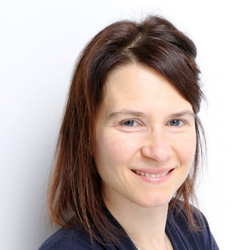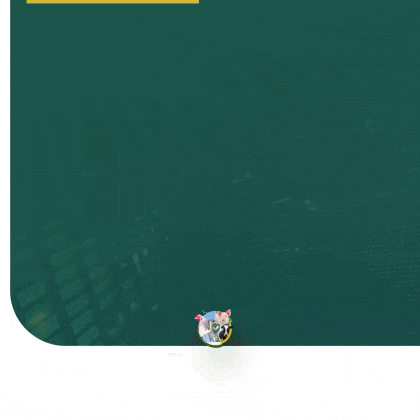Mechanistic modeling can be used to predict phosphorus and calcium requirements for swine and poultry.
Calcium (Ca) and phosphorus (P) should be provided in feed to swine and poultry in precise and balanced amounts according to the growth phase and rate or production status. Both minerals are implied in ossification, eggshell formation, and milk production. Consequently, accurate determination of needs for both minerals has animal well-being and production impacts.
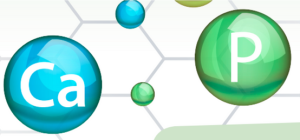
Additionally, both minerals interact for proper absorption and utilization and should be studied together, but many other dietary factors can impact their requirements. For example, phytase supplementation, vitamin D sources, levels of protein, fat, and organic acids. The solubility of the minerals and the particle size may also impact their utilization. The efficiency of phytases or the biopotency of vitamin D sources can impact these needs. The requirement or optimum levels of Ca and P also vary depending on the criteria to optimize. Bone ash or bone strength requires higher levels than growth or feed utilization efficiency, which varies with age. Lately, another criterion is to minimize P excretion to the environment.
The complex characteristics to determine Ca and P requirement makes modeling one of the best methodologies to attempt complete understanding and more accurate calculation seeking multicriteria. Models can aid in calculating the effects of phytases, depletion, and repletion strategies to prime the animal to be more efficient, and finally combining these strategies into a precision feeding model that provides daily tailored diets for individual pigs or flocks of birds with similar conditions. This tool also predicts the amount of P excreted in the slurry.
Phosphorus has received more attention lately due to its impact on the sustainability of animal production for two different reasons. On one side, phosphorus is a non-renewable resource, and mined sources have become scarce worldwide. The prices have skyrocketed in the past months, with a tendency to reach the historic maximum observed in October 2008, or US$450 per ton (Figure 1). On the other side, phosphorus excretion can quickly cause over-fertilization in soils because plant uptake can be lower than deposition, and water has great eutrophication potential, which leads to an increase in aquatic plant growth.

Figure 1. World’s average prices (US Dollar per metric ton) of phosphate rock prices from 1960 to October 2022. Source World Bank.
On the other hand, Ca is abundant in nature, its excretion does not threaten the environment, and almost always one of the cheapest nutrients in monogastric diets. Nevertheless, Ca has essential metabolic functions in animals, and its dietary level impacts the absorption and utilization of P and many other minerals. Ca is indispensable for bone mineralization, eggshell formation, muscle contraction, and nerve impulse propagation. In poultry, high Ca levels increase gizzard pH and reduces the activity of some exogenous phytases and other exogenous or endogenous enzymes.
A mechanistic model approach aims to represent the mechanisms of a system connecting the underlying mechanisms that control it. The research group led by Dr. Marie-Pierre Létourneau-Montminy at theUniversity of Laval, in collaboration with other Universities and research institutes like Universidade Estadual Paulista, UNESP, in Brazil, INRAE, in France, Agriculture and Agri-Food Canada AAFC, and the University of Maryland, has developed mechanistic mathematical models that simulate the fate of dietary P forms, phytate P (PP) and non-phytate P (NPP) from the plant, mineral, and animal origin, in the gastrointestinal-tract.

The proposed model integrates and predicts the impact of the most relevant physiological processes involved in P digestion and absorption, including P dietary forms, exogenous phytase, and the dietary concentration of Ca. It also predicts the impact of transit time and pH of the different dietary sections. The output is the standardized P and Ca absorbed. It can be used as a prospective tool to study P digestibility for different feedstuffs and feeding strategies and the effect of specific digestive processes on P digestive utilization.
The assessment of Ca and P requirements must consider that changes in skeletal tissue are not directly proportional to lean growth. The models developed by the group of Dr. Létourneau-Montminy allow P and Ca requirements for soft tissue growth and bone growth to be predicted independently. These models also include the factorial approach, which consists of quantification and adding the requirements for each physiological function. This means maintenance, growth or gain, and egg production.
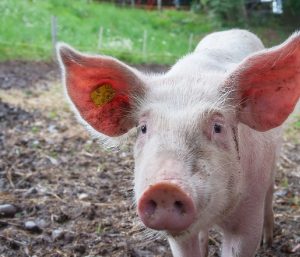 Pig model
Pig model
This new model for pigs estimates apparent digestible Ca and P requirements, which can be converted to the standardized total tract digestibility (STTD) or total requirements. The only input required is the initial body weight, from which body protein, lipid, water, and ash (soft tissue and bone) are estimated.
Soft tissue growth is estimated by applying the principles of the InraPorc Model. However, other models, such as NRC (2012) or even user-specific equations tailored to animal growth in a specific setting, may be adequate. Estimated protein and lipid gains are used to assess P and Ca retention in soft tissues. In parallel, the Ca requirement for bone is estimated with the bone Ca potential deposition curve also available. The deposition of P in bone is estimated at a fixed ratio of 2.16 to Ca deposition. The maintenance requirements, equivalent to the obligatory urinary losses, are set at 0.5 mg for P and 2 mg for Ca per kg of body weight. The sum of the maintenance and growth requirements (of soft tissue and bone) thus provides apparent digestible P and Ca requirements. The Ca:digestible P requirements ratio increased with body weight because protein deposition, in which 30-40% of the P is deposited, decreases while bones continue to grow after 70 kg of BW. These requirements can be converted to a standardized or total basis.

Figure 2. General layout of the mechanistic model predicting total calcium (Ca) and apparent and standardized digestible phosphorus (ATTD and STTD P) requirements of growing pigs.
The evaluation results of this model confirmed the need for a non-fixed Ca:P requirement ratio. This model can be adaptable to different production objectives, such as 100% or 85% mineralization, without decreasing the share of Ca or P destined for soft tissues. Although a single deposition potential has been established, it will become necessary to consider animal genetics and/or sex in further validations of the model.
The sensitivity analysis of the model showed that protein deposition influenced apparent total tract digestibility ATTD-P variance by 15% for pigs at 30 kg, 6% at 60 kg, and 1% at 120 kg based on protein deposition variation observed in previous trials. The decrease in the influence of protein deposition on P with BW increases coincides with the linear increase in the bone deposition. Moreover, the ATTD-P variance associated with protein deposition at 30 kg shows that animal growth will significantly impact P recommendations.
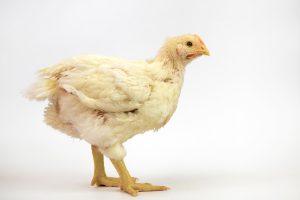 Broiler Model
Broiler Model
The mechanistic model partitioning Ca and P in the broiler body enables us to understand the dynamics of the utilization of these minerals in the body compartments and predict and even influence the Ca and P excretion to the environment. A model was developed to estimate the metabolic fate of Ca and P in broiler chickens, opening an opportunity to understand and quantify the requirements of those minerals as broilers aged. The model is described in Figure 3.
The model explains the digestion of both minerals, absorption, transport to soft tissue, and body ash accumulation. The body ash and soft tissue are divided into four ash compartments: bone, body protein or lean muscle, body lipid, and feather protein.
The digestion module is based on data generated with a meta-analysis using preceacal digestibility data. The soft tissue module is based on a growth model included in the software Broiler Growth Model – BGM, available online and developed by the group led by Dr. Nilva Sakomura from Universidade Estadual Paulista, Jaboticabal, São Paulo, Brazil. The body ash modules are a summatory of the impact on bone ash and soft tissues, including protein and lipids.
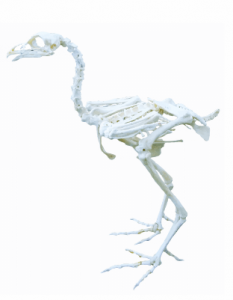
![]() Calculating the Ca and P requirement for maximum bone deposition is based on determining and adding maintenance and gain requirements.
Calculating the Ca and P requirement for maximum bone deposition is based on determining and adding maintenance and gain requirements.
This model can predict the daily requirement of Ca and P to maximize bone mineralization in growing broilers. It also predicts the effects of high Ca on growth performance by reducing feed intake while maximizing bone mineralization. In broilers, the literature showed that the growth of body ash is closer to protein growth than in swine based on allometry equations. Therefore, although the prediction of body ash growth independently of protein growth offers better accuracy, further investigation is ongoing to understand this issue better.
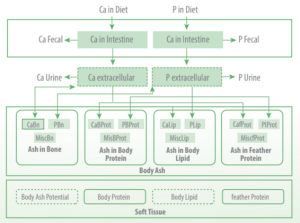
Figure 3. Model diagram indicating the three main model steps (thin solid line boxes), digestion, body ash, and soft tissue. Large solid line boxes are state variables, dashed lines are zero pools, and dotted lines are auxiliary variables. Arrows indicate flows.
The proposed models can be integrated into software that can aid in making all these calculations in seconds using all inputs desired. This approach has more potential to enhance understanding and integrate the knowledge of feed and animals for a more accurate estimation of nutrient needs. Similar models are under development for layers and sows and will be described in a future issue of NutriNews International.
Source: This article was written as a collaboration between the following authors: Marie-Pierre Létourneau-Montminy, University of Laval, Canada; Nilva K. Sakomura, Universidade Estadual Paulista, UNESP, Jaboticabal, Brazil; Matheus Reis, Universidade Estadual Paulista, UNESP, Jaboticabal, Brazil; Edgar O. Oviedo-Rondón, North Carolina State University, Raleigh, NC., USA.



